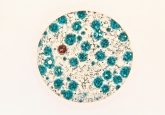Paper-based dried sampling approaches for PK analysis: limitations and possibilities

Melanie Anderson is a principal scientist at Merck Research Laboratories and runs a small group in the Clinical Regulated Bioanalysis Space. Melanie has over 15 years experience in both Pharma and CRO settings conducting LC-MS/MS analysis for quantitation of small molecules and peptides. Melanie has participated in FDA inspections and contributed to regulatory filings. Additionally, Melanie has experience in non-compartmental pharmcokinetic analysis of atypical compounds.
She received her B.A. in Chemistry from Hasting College in 2002, and a M.S. in Chemistry from Lehigh University in 2007. Melanie’s scientific interests include analysis of unique matrices, unstable compounds, challenges in chromatographic separations, and at home micro sampling approaches for regulated clinical trials. Recently, Melanie has evaluated and helped implement micro sampling devices in animal and human regulated studies.
Keywords: Paper-based sampling, DBS, VAMSTM, NoviplexTM
Paper-based dried sampling technologies involve absorbing liquid biological matrices such as blood, plasma, saliva and urine on a sorbent such as filter paper, small fiberglass sheets or a polymer. Paper-based sampling provides opportunities to collect biological samples in the dried state and involves significantly smaller sample volumes than traditional sample collection approaches. Dried blood spots (DBS) are one of the most common paper-based technologies and can be generated from finger sticks, heel sticks or from blood obtained in venous blood draws.
Paper-based technologies like DBS have been widely used in health care for decades as they can provide smaller sample volumes and ambient sample storage conditions. The greatest success of the application of paper-based technology is the US Center for Disease Control newborn screening program, which tests for congenital diseases using DBS sampling from a single heel stick. DBS meets the need for smaller sample volumes in this population [1]. Paper-based technology is also widely employed for therapeutic drug monitoring applications such as HIV drug monitoring [2,3]. In the pharmaceutical industry, interest in paper-based technologies for pharmacokinetic (PK) sample analysis in clinical trials has increased in the last decade [4–7]. GSK was an early champion of the DBS approach and broadly implemented the dried sample approach for PK sample analysis [8,9]. Other large pharma companies soon followed [6,7]. The ability to enable PK sample collection in the home setting is valuable for certain indications. For example, migraine efficacy studies cannot be conducted at clinical sites due to the unpredictable nature of migraine attacks [10]. In such cases, DBS collection from a finger stick can enable pharmacokinetic-pharmacodynamic work, but there are liabilities to this approach.
Paper-based technologies miniaturize sample volumes and may be considered less invasive than traditional venous sample collection. Detection limits for LC–MS/MS are continually improving, enabling smaller and smaller sample volumes. In severely ill patients or pediatrics, smaller sampling volumes are highly desirable. The ability to couple paper-based technologies with LC–MS/MS can enable multi-analyte analysis from a single sample further decreasing sample volume needs. In addition, collecting reliable samples without centrifugation using ambient storage conditions enables sample collection in locations with limited access to electricity. This can potentially expand clinical trial access for patients all over the world. The ability to collect samples from a finger stick or other sources without trained clinical staff is a significant advantage. This simpler, less invasive collection approach enables at home collection further expanding opportunities to generate larger, more meaningful clinical data sets. In large clinical trials, it is prohibitively expensive to incorporate clinical site visits and obtaining a read on PK and patient adherence is difficult. If at home sampling can be implemented reliably, paper-based technologies can potentially provide richer data sets at an affordable price [10]. Finally, paper-based technologies can present more savings through ambient shipping and storage, which is a more affordable approach [3].
Although there are many advantages to paper-based approaches, there are significant challenges. Technologies have evolved to make these approaches successful in sample collection, sample integrity and sample analysis. Some of these obstacles have been handled by laboratory scientists solving issues related to sample analysis. However, more work remains before the potential of paper-based approaches in PK analysis and in all of health care can be fully realized.
Challenges in both sample collection and sample integrity can be significant. Finger stick DBS sample collection performs reliably in the clinical site setting, but in past clinical trials patient-collected samples had poor blood spot quality, which increased variability in PK results [11]. In addition, finger stick sampling can be painful, especially with intensive sampling. More than one finger stick a day can lead to compliance issues and may be more painful than a blood draw through a venous catheter. Potential alternatives to finger stick sampling are beginning to hit the market. The Seventh Sense Biosystems TAPTM device and the Tasso HemoLinkTM may provide viable alternatives to venous and finger stick blood collection. Both devices collect small amounts of liquid blood from the upper arm in simple, convenient ways. If such devices can be successfully coupled to paper-based technologies, they may revolutionize sample collection in the entire health care industry. Another potential concern for paper-based approaches is controlling the sampling sorbents’ environmental exposures prior to sample collection, which may be more of concern in large global trials and in home sampling. A variety of DBS cards and other alternative sorbents are available. Some of these are coated with surfactants. The temperature and humidity exposure on the absorbing and coating chemistries employed can be difficult to determine.
The ability of new sampling approaches to fit into existing laboratory workflows is a concern. Automation for sample analysis is important for laboratory efficiency across the industry. There are several automation approaches for DBS samples but alternative dried sampling technologies may require more manual manipulation until workflows can be optimized. This may, in the short-term, place an extra burden on laboratory personnel. It is important to have champions for new technology, as change can be difficult especially in large organizations with existing workflows.
Another need in this space is bridging PK studies to find the correlation between plasma and blood data, if a program has generated both liquid plasma and dried blood data [5,6]. Paper-based devices like the Novilytic Plasma Prep Cards NoviplexTM and the AdvanceDx100TM Blood Separator Collection Card have been developed to provide paper-based plasma samples by filtering out red blood cells. The NoviplexTM device provides a metered amount of plasma from a small amount of blood and is compatible with most PK laboratory workflows [14]. The AdvanceDx100TM needs more blood for migration across a sorbent and is not as amenable to existing PK laboratory workflows. However, the AdvanceDx100TM is showing promise in the diagnostic space. Such devices may avoid the need for bridging PK studies. However, it is still unclear if plasma created from centrifugation in liquid sampling is the exact same matrix as plasma created by filtration in paper-based sampling. If there are differences between these matrices, additional bridging PK studies may still be needed and the primary advantage to this approach is lost.
In the sample analysis of paper-based technologies, sensitivity, matrix effect, stability, recovery, and hematocrit (Htc) effect can be significant hurdles. LC–MS/MS analysis can often resolve sensitivity concerns and matrix effects can be addressed with appropriate sample preparation and may be mediated with the use of stable-isotope labeled internal standard. Assessing stability can be difficult, as exposures to temperature and humidity fluctuations in shipping and storage are difficult to record for the entire life of the sample. This is especially true in large Phase III clinical trials, when clinical sites are all over the globe and central laboratories on different continents can have widely differing environmental conditions. Recovery can also be difficult to assess, as recovery in paper-based samples can depend on the age of the samples. That is, for some analytes the older the sample is, the lower the recovery. Therefore, the corresponding quantitative results will be biased lower. This issue can be easily conflated with analyte stability but may in fact be due to extraction efficiency differences in the dried state with relation to time [6,7]. It is imperative that assays have high recovery to mediate this effect and that laboratories understand the liabilities in their assay. Htc effects are a well-known issue with some paper-based approaches such as DBS. In addition, the ability to extract compound back off the card can be influenced by Htc and therefore Htc differences may impact recovery. Htc differences in the blood can impact the spread of the blood droplet across the DBS card causing a bias in the data [5,6]. To mediate the Htc effect from spot spread, technologies have been developed to deliver known amounts of blood from finger stick sampling. Several devices using capillary-based blood transfer from a finger stick are in development. The Neoteryx VAMSTM MitraR tip is a polymeric sorbent that absorbs a known amount of blood providing a viable alternative to DBS card sampling [12,13].
Obtaining reliable samples in the home setting is also a huge challenge. It is extraordinarily difficult to adequately communicate and train subjects to collect samples outside the clinical site. Therefore, the sampling technique needs to be easy and efficient requiring very little manipulation by the subject. Indeed even finger stick-DBS spotting conducted at home increased variability due to sampling issues [11]. The time of sample collection also needs recording in the at home setting, requiring investment in data analytics. A non-invasive device that collects blood painlessly, provides a dried sample for ambient shipping, and provides time of collection information is desperately needed in this space and is yet to emerge. Additionally, regulators have raised questions around patient identity when samples are obtained outside the clinical site. DNA profiling can successfully resolve the identity question, however, it is too expensive to implement on a large scale.
Although the challenges are significant, paper-based approaches present huge opportunities in health care. If these technologies can be successfully incorporated into clinical trials enabling better data at lower costs, they may revolutionize the pharmaceutical industry. Acquiring more data in a potentially less invasive way is desirable across the healthcare industry for both clinical studies and diagnostics. The advent of patient-centric, personalized health care will drive innovation in sample collection, sample analysis and data analytics. At home sampling will provide more data to medical professionals and convenience for patients. Paper-based technologies will be a key component of this evolution.
References:
- Guthrie R, Susi A. A simple phenylalanine method for detecting phenylketonuria in large populations of newborn infants. Pediatrics 32(3),338–343(1963).
- Hoogtanders K, van der Hwijden J, Christiaans M, van de Plas A, van Hooff J, Stolk L. Dried blood spot measurement of tacrolimus is promising for patient monitoring. Transplantation 83(2), 237–238 (2007).
- Smit PW, Sollis KA, Fiscus Set al. Systematic review of the use of dried blood spots for monitoring HIV viral load and for early infant diagnosis. PLoS ONE9(3), e86461 (2014).
- Beaudette P, Bateman KP. Discovery stage pharmacokinetics using dried blood spots. J. Chromatogr. B. Analyt. Technol. Biomed. Life Sci. 809(1), 153–158 (2004).
- Emmons G, Rowland M. Pharmacokinetic considerations as to when to use dried blood spot sampling. Bioanalysis2(11), 1791–1796 (2010).
- Xu Y, Woolf EJ, Agrawal NG, Kothare P, Pucci V, Bateman KP. Merck’s perspective on the implementation of dried blood spot technology in clinical drug development—why, when and how. Bioanalysis5(3), 341–350 (2013).
- Li W, Tse FLS. Dried blood spot sampling in combination with LC-MS/MS for quantitative analysis of small molecules. Biomed. Chromatog. 24(1), 49–65 (2010).
- Barfield M, Spooner N, Lad R, Parry S, Fowles S. Application of dried blood spots combined with HPLC-MS/MS for the quantification of acetaminophen in toxicokinetic studies. J. Chromatograph B. 870 (1), 32–37 (2008).
- Spooner N, Lad R, Barfield M. Dried blood spots as a novel sample collection technique for the determination of pharmacokinetics in clinical studies: considerations for the validation of a quantitative bioanalytical method. Anal. Chem. 81(4), 1557–1563 (2009).
- Kothare PA, Bateman KP, Dockendorf M, Stone J, Xu Y, Woolf E, Shipley LA. An integrated strategy for implementation of dried blood spots in clinical development programs. AAPS J. 18(2), 519–527 (2016).
- Dockendorf M, Li C-C, Kowalski K, Yang B, Ma L, Kleijn H, Bosch R, et al. Population modeling is a critical element of bridging pharmacokinetic (PK) data from Dried Blood Spot (DBS) and plasma across clinical programs. Poster presented at: AAPS 2014.
- Denniff P, Spooner N. Volumetric absorptive microsampling: A dried sample collection technique for quantitative bioanalysis. Anal. Chem. 86(16), 8489–8495 (2014).
- De Kesel PMM, Lambert WE, Stove CP. Does volumetric absorptive microsampling eliminate the hematocrit bias for caffeine and paraxanthine in dried blood samples? A comparative study. Anal. Chim. Acta.881, 65–73 (2015).
- Kim JH, Woenker T, Adamec J, Regnier FE. Simple, miniaturized blood plasma extraction method. Anal. Chem. 85(23), 11501–11508 (2013).





